Rare infection easily misdiagnosed, delaying treatment
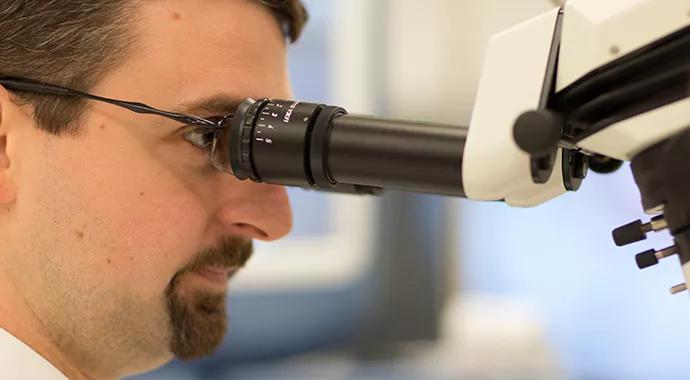
Contact lens-related microbial keratitis affects approximately 1 in 500 soft contact lens wearers annually in the United States. Most infections are bacterial in origin and can be managed empirically, often resolving without significant visual sequelae. In some cases, unusual organisms infect the cornea that are resistant to standard broad spectrum antibiotics. One such genus of protozoa, Acanthamoeba, is a rare but important cause of infectious keratitis. Infections caused by Acanthamoeba sp. are often misdiagnosed, initially resulting in a delay in definitive treatment.
Cleveland Clinic is a non-profit academic medical center. Advertising on our site helps support our mission. We do not endorse non-Cleveland Clinic products or services. Policy
A 37-year-old female presented to Jeffrey Goshe, MD, for a second opinion regarding chronic right eye pain and photophobia after being treated nine months earlier for an acute corneal ulcer with hypopyon in the setting of contact lens wear. Routine bacterial and fungal cultures were obtained and topical fortified antibiotics were started hourly. Initial cultures were positive for Pseudomonas aeruginosa and the antibiotics were adjusted accordingly. Over the next three months, the ulcer gradually healed and topical steroids were added to reduce the inflammatory response.
After four months, topical steroids were discontinued and the patient reported that her symptoms had resolved. Three weeks later, she experienced recurrent photophobia and eye pain. Steroids were restarted due to a presumed post-inflammatory reaction to initial infection. Over the subsequent four months, multiple attempts were made to taper topical steroids, but the patient was unable to do so due to worsening photophobia and eye pain.
At the time she presented for a second opinion, she was using loteprednol 0.5% (Lotemax®) drops twice daily. She had not worn contact lenses since the initial infection was diagnosed. She complained of 8/10 pain and extreme photophobia OD. Her vision was 20/200. Slit lamp examination (Figure 1) revealed mild diffuse limbal injection, with an area of increased hyperemia superiorly. Her cornea exam was remarkable for a central oval-shaped scar in the area of her original corneal ulcer. Multiple subepithelial infiltrates were present in a ring pattern circumferentially around the peripheral cornea. There was no epithelial defect.
Based on the clinical appearance and symptoms, Acanthamoeba infection was suspected. Culture was deferred as there was no epithelial defect. Confocal microscopy was performed revealing multiple double-walled reflective structures consistent with Acanthamoeba cysts (Figure 2)
Treatment with topical chlorhexidine gluconate 0.02% was started hourly and the loteprednol was decreased to once daily. One week later, the patient reported significant reduction in her pain and photophobia. One month later, her symptoms had completely resolved with near resolution of the ring infiltrate noted previously (Figure 3). Steroids were tapered off over the next two months and she was maintained on topical chlorhexidine four times daily. As of her most recent visit, vision was improved to 20/40 with correction.
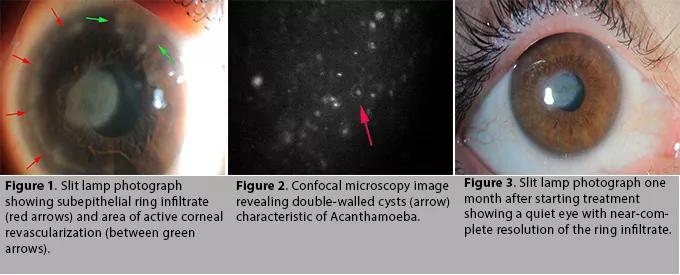
A 20-year-old college student returned to Jeffery Goshe, MD, with acute onset of worsening left eye pain, vision and photophobia over the previous three days. Her history was remarkable for culture-positive Acanthamoeba keratitis diagnosed two years prior at the Cole Eye Institute. She completed a 12-month course of topical treatment with chlorhexidine gluconate 0.02%, polyhexamethylene biguanide (PH MB) 0.02% and propamide isethionate 0.1% (Brolene®), after which time her symptoms had resolved and there were no signs of active inflammation. Treatment was discontinued and she was monitored without signs of recurrence for the subsequent three months.
At the time of her second presentation, she had been off all treatment for nine months. She had not worn contact lenses for the past two years. Her best-corrected vision was 20/20 OD and 20/60 OS (previously 20/40 OS at the time of her last appointment six months earlier).
Her right eye examination was normal. Her left eye was remarkable for mild to moderate diffuse limbal injection. Superficial corneal neovascularization was present superiorly. Of note, focal mid-stromal neovascularization was visible, extending into the area of temporal corneal infiltration (Figure 4). The epithelium was intact. The anterior chamber examination revealed a faint cellular reaction without hypopyon.
In light of her clinical history, the constellation of symptoms and signs was suggestive of recurrent Acanthamoeba keratitis and treatment was re-initiated with chlorhexidine and Brolene OS. Oral ketoconazole 100mg daily was added to provide additional Acanthamoeba coverage. During the first two weeks after restarting treatment, there was an increase in corneal edema causing her vision to decrease to 20/200 (Figure 5). Anterior segment optical coherence tomography demonstrates the depth of infiltration and surrounding edema (Figure 6).
After six weeks of treatment, prednisolone acetate was started once daily. Within one week, the edema was nearly resolved with her best-corrected vision returning to 20/60. As of her most recent follow-up, her vision has improved to 20/50 and her pain and photophobia have completely resolved.
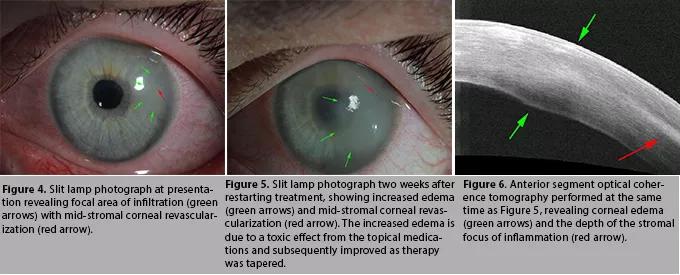
Cautious use of topical corticosteroids may be beneficial after completing one to two months of anti-infective treatment to reduce symptoms and corneal scarring. Topical steroids must be used with caution and for the shortest possible duration as they may inhibit some innate immune mechanisms necessary to eradicate Acanthamoeba organisms.
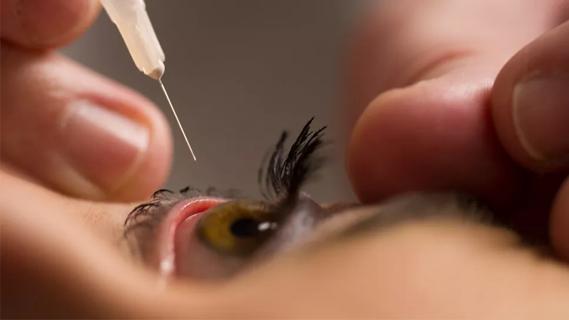
Study highlights the value of quantitative ultra-widefield angiography
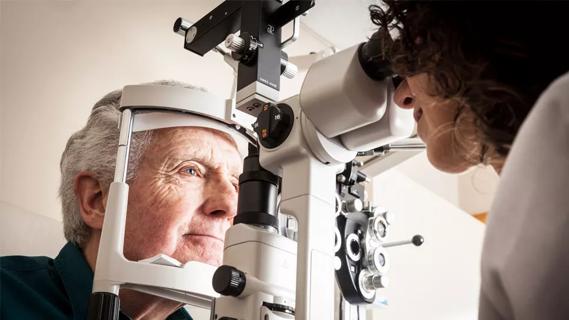
Switching medications may decrease treatment burden and macular fluid
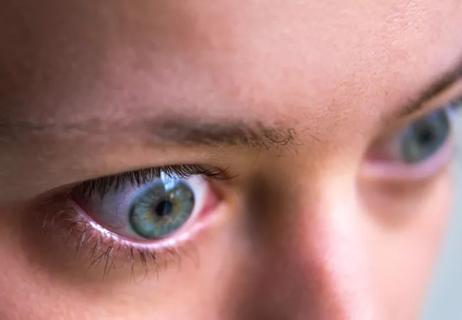
Interventions abound for active and stable phases of TED
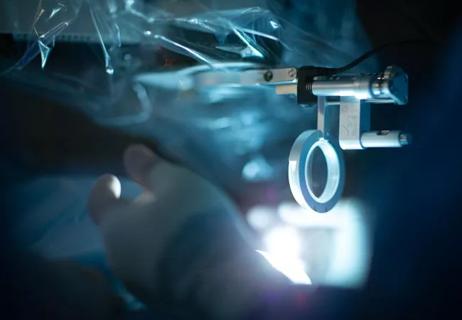
Corneal imaging and interpretation play a major role
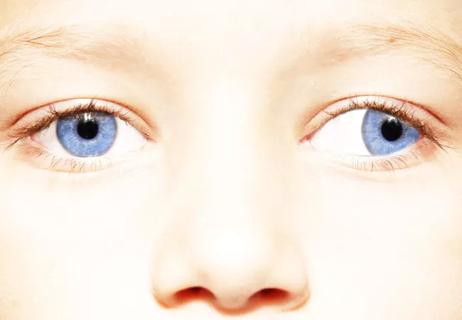
Effect of low-dose atropine and dual-focus contact lenses is unknown in patients with comorbid eye conditions

How to screen for and manage treatment-triggered uveitis

Minimally invasive surgery is effective for uveitic and steroid-induced glaucoma too
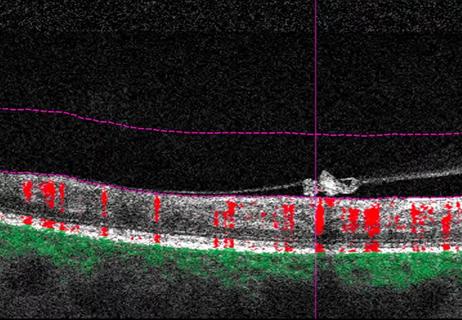
Why retina specialists should get comfortable with this imaging tool